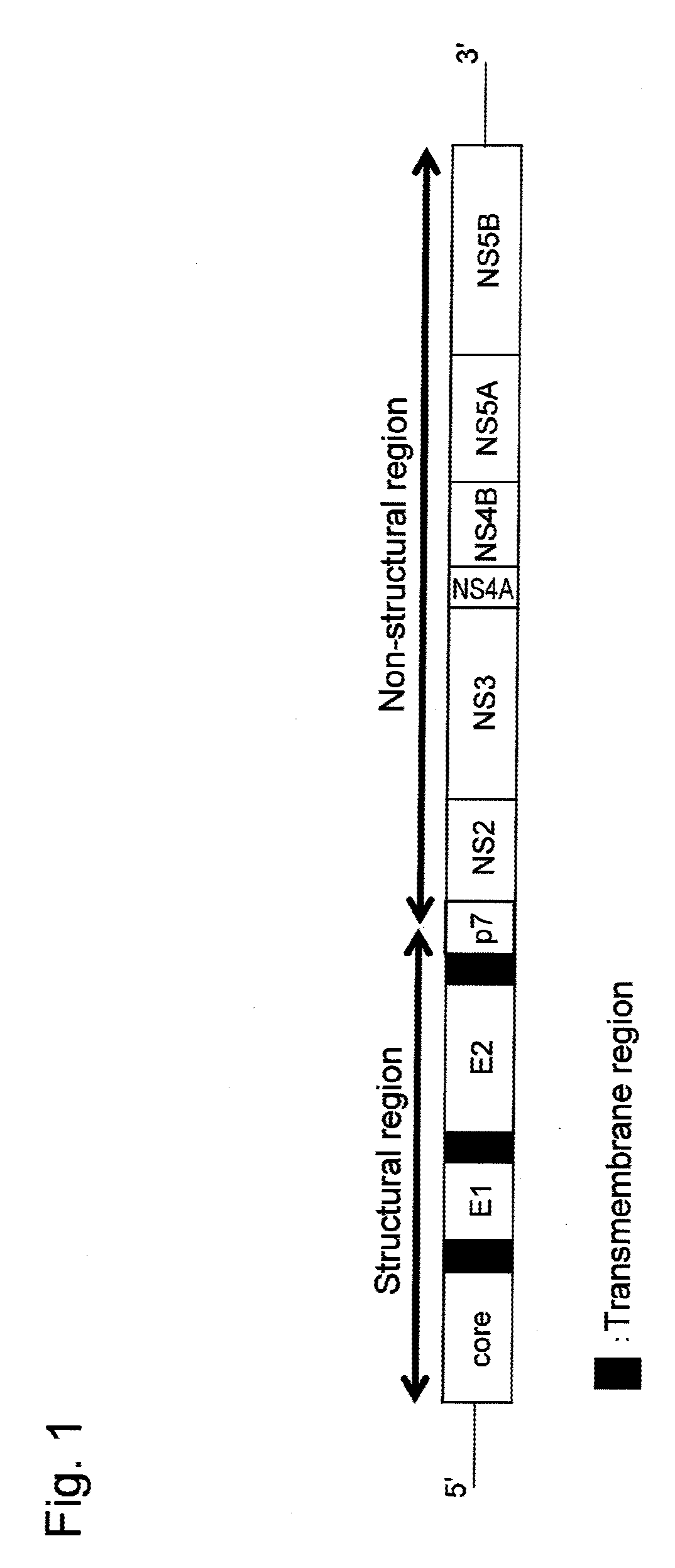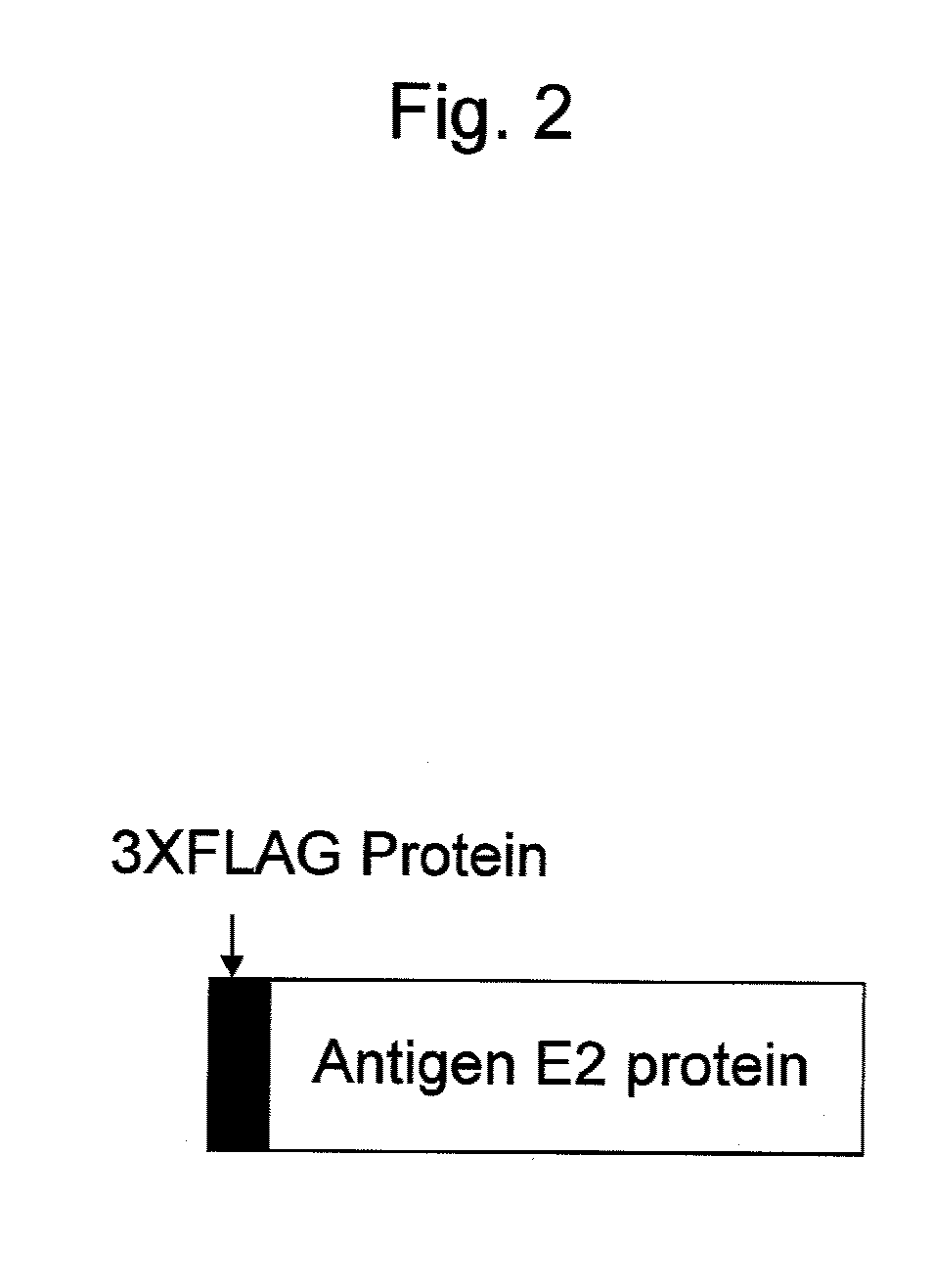Antibody binding to envelope protein 2 of hepatitis c virus and method for identifying genotype of hepatitis c virus using the same
- Summary
- Abstract
- Description
- Claims
- Application Information
AI Technical Summary
Benefits of technology
Problems solved by technology
Method used
Image
Examples
example 1
Preparation of Vector for Expression of Fusion Protein of Antigen E2 Protein of HCV Strain and Labeling Protein
[0096](1) Construction of Vector for Expression of Fusion Protein of Antigen E2 Protein Derived from J6CF Strain of HCV2a and 3xFlag Tag
[0097]The antigen E2 protein derived from the J6CF strain of HCV2a; that is, a protein consisting of the region without transmembrane region of the E2 protein of the J6CF strain of HCV2a, was prepared as described below.
[0098]First, a gene encoding a protein consisting of a region corresponding to amino acid positions 384 to 720 of the precursor protein (SEQ ID NO: 5) of the J6CF strain, when the initiation methionine at the N-terminus was determined to be the 1st amino acid, was amplified by a PCR method using the cDNA of the genomic RNA of the J6CF strain of HCV2a (GenBank Accession No. AF177036) as a template, an Advantage GC2 PCR kit (Takara Bio Inc.), and J6E2dTM-s (SEQ ID NO: 6: CACAAGCTTCGCACCCATACTGTTGGGG) and J6E2dTM-as (SEQ ID NO:...
example 2
Expression of Fusion Protein of Antigen E2 Protein and Labeling protein
[0124]CMV-3xFLAGJ6E2dTM, CDM-J6E2Fc, CDM-JFH1E2Fc, CDM-THE2Fc, CDM-Con1E2Fc, SRα-J1E2Fc, and SRα-H77E2Fc constructed in Example 1 were introduced into monkey kidney-derived COS1 cells and then each fusion protein was expressed as described below.
[0125]First, COS1 cells were subcultured in RPMI1640 medium (Invitrogen Corporation) containing 10% fetal calf serum (Invitrogen Corporation), 100 U / ml penicillin, and 100 μg / ml streptomycin. On the day before the gene transfer, COS1 cells were seeded in 150 cm2 culture flasks (Corning Coaster Corporation) at a split ratio of 1:2 and then cultured overnight at 37° C. in a 5% CO2 incubator.
[0126]Subsequently, DEAE dextran (GE Healthcare) and chloroquine (Sigma) were added to RPMI1640 medium at final concentrations of 400 μg / ml and 100 μM, respectively. 50 μg of the above expression vector (CMV-3xFLAGJ6E2dTM, CDM-J6E2Fc, CDM-JFH1E2Fc, CDM-THE2Fc, CDM-Con1E2Fc, SRα-J1E2Fc, o...
example 3
Purification of Fusion Protein of Antigen E2 Protein and Labeling Protein
[0129]The culture supernatant of cells into which CMV-3xFLAG-J6E2dTM had been introduced was subjected to purification using anti-FLAG M2 agarose (Sigma) as described below.
[0130]First, 1 ml of anti-FLAG M2 agarose was added to 500 ml of the culture supernatant and then allowed to react at 4° C. for 2 hours during stirring in a spinner bottle. After 2 hours, a mixture of the supernatant and anti-FLAG M2 agarose was transferred to Econocolumn (Bio-Rad Laboratories Inc.), the Void fraction was removed, and then anti-FLAG M2 agarose was collected.
[0131]Next, anti-FLAG M2 agarose was washed twice with 10 ml of TBS (50 mM Tris-HCl, 150 mM NaCl, pH 7.4). Six fractions (anti-FLAG antibody column elution fractions 1-6) were eluted with 0.1 M Glycine-HCl (pH 3.5) to 1 ml / fraction. Immediately after elution, 1M Tris-HCl (pH 9.5) was added to return the pH to neutral. 20 μl of each fraction was fractionated under reductiv...
PUM
 Login to View More
Login to View More Abstract
Description
Claims
Application Information
 Login to View More
Login to View More - R&D
- Intellectual Property
- Life Sciences
- Materials
- Tech Scout
- Unparalleled Data Quality
- Higher Quality Content
- 60% Fewer Hallucinations
Browse by: Latest US Patents, China's latest patents, Technical Efficacy Thesaurus, Application Domain, Technology Topic, Popular Technical Reports.
© 2025 PatSnap. All rights reserved.Legal|Privacy policy|Modern Slavery Act Transparency Statement|Sitemap|About US| Contact US: help@patsnap.com



